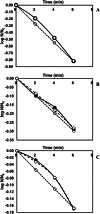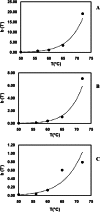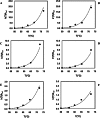Thermal Inactivation Kinetics of Human Norovirus Surrogates and Hepatitis A Virus in Turkey Deli Meat
- PMID: 25956775
- PMCID: PMC4551186
- DOI: 10.1128/AEM.00874-15
Thermal Inactivation Kinetics of Human Norovirus Surrogates and Hepatitis A Virus in Turkey Deli Meat
Abstract
Human noroviruses (HNoV) and hepatitis A virus (HAV) have been implicated in outbreaks linked to the consumption of presliced ready-to-eat deli meats. The objectives of this research were to determine the thermal inactivation kinetics of HNoV surrogates (murine norovirus 1 [MNV-1] and feline calicivirus strain F9 [FCV-F9]) and HAV in turkey deli meat, compare first-order and Weibull models to describe the data, and calculate Arrhenius activation energy values for each model. The D (decimal reduction time) values in the temperature range of 50 to 72°C calculated from the first-order model were 0.1 ± 0.0 to 9.9 ± 3.9 min for FCV-F9, 0.2 ± 0.0 to 21.0 ± 0.8 min for MNV-1, and 1.0 ± 0.1 to 42.0 ± 5.6 min for HAV. Using the Weibull model, the tD = 1 (time to destroy 1 log) values for FCV-F9, MNV-1, and HAV at the same temperatures ranged from 0.1 ± 0.0 to 11.9 ± 5.1 min, from 0.3 ± 0.1 to 17.8 ± 1.8 min, and from 0.6 ± 0.3 to 25.9 ± 3.7 min, respectively. The z (thermal resistance) values for FCV-F9, MNV-1, and HAV were 11.3 ± 2.1°C, 11.0 ± 1.6°C, and 13.4 ± 2.6°C, respectively, using the Weibull model. The z values using the first-order model were 11.9 ± 1.0°C, 10.9 ± 1.3°C, and 12.8 ± 1.7°C for FCV-F9, MNV-1, and HAV, respectively. For the Weibull model, estimated activation energies for FCV-F9, MNV-1, and HAV were 214 ± 28, 242 ± 36, and 154 ± 19 kJ/mole, respectively, while the calculated activation energies for the first-order model were 181 ± 16, 196 ± 5, and 167 ± 9 kJ/mole, respectively. Precise information on the thermal inactivation of HNoV surrogates and HAV in turkey deli meat was generated. This provided calculations of parameters for more-reliable thermal processes to inactivate viruses in contaminated presliced ready-to-eat deli meats and thus to reduce the risk of foodborne illness outbreaks.
Copyright © 2015, American Society for Microbiology. All Rights Reserved.
Figures



Similar articles
-
A comparison of the thermal inactivation kinetics of human norovirus surrogates and hepatitis A virus in buffered cell culture medium.Food Microbiol. 2014 Sep;42:212-7. doi: 10.1016/j.fm.2014.04.002. Epub 2014 Apr 16. Food Microbiol. 2014. PMID: 24929739
-
Determination of the thermal inactivation kinetics of the human norovirus surrogates, murine norovirus and feline calicivirus.J Food Prot. 2013 Jan;76(1):79-84. doi: 10.4315/0362-028X.JFP-12-327. J Food Prot. 2013. PMID: 23317860
-
Thermal inactivation of human norovirus surrogates in spinach and measurement of its uncertainty.J Food Prot. 2014 Feb;77(2):276-83. doi: 10.4315/0362-028X.JFP-13-289. J Food Prot. 2014. PMID: 24490922
-
Thermal Inactivation of Foodborne Enteric Viruses and Their Viral Surrogates in Foods.J Food Prot. 2015 Aug;78(8):1597-617. doi: 10.4315/0362-028X.JFP-14-487. J Food Prot. 2015. PMID: 26219377 Review.
-
Heat stability of foodborne viruses - Findings, methodological challenges and current developments.Int J Food Microbiol. 2024 Mar 2;413:110582. doi: 10.1016/j.ijfoodmicro.2024.110582. Epub 2024 Jan 25. Int J Food Microbiol. 2024. PMID: 38290272 Review.
Cited by
-
Norovirus Genogroup II Epidemics and the Potential Effect of Climate Change on Norovirus Transmission in Taiwan.Viruses. 2022 Mar 20;14(3):641. doi: 10.3390/v14030641. Viruses. 2022. PMID: 35337048 Free PMC article.
-
Microbial Dose-Response Curves and Disinfection Efficacy Models Revisited.Food Eng Rev. 2021;13(2):305-321. doi: 10.1007/s12393-020-09249-6. Epub 2020 Aug 28. Food Eng Rev. 2021. PMID: 40477138 Free PMC article. Review.
-
Modeling the Inactivation of Viruses from the Coronaviridae Family in Response to Temperature and Relative Humidity in Suspensions or on Surfaces.Appl Environ Microbiol. 2020 Sep 1;86(18):e01244-20. doi: 10.1128/AEM.01244-20. Print 2020 Sep 1. Appl Environ Microbiol. 2020. PMID: 32680860 Free PMC article.
-
Inactivation of Aerosolized Hepatitis A Viral Droplets on Food Contact Surfaces by Ultraviolet-Light-Emitting Diodes at 255 nm and 279 nm.Foods. 2025 May 27;14(11):1899. doi: 10.3390/foods14111899. Foods. 2025. PMID: 40509428 Free PMC article.
-
Dynamical Differences in Respiratory Syncytial Virus.Bull Math Biol. 2021 Nov 30;84(1):11. doi: 10.1007/s11538-021-00971-8. Bull Math Biol. 2021. PMID: 34850293 Free PMC article.
References
-
- USDA Food Safety and Inspection Service (FSIS). 2003. Quantitative assessment of relative risk to public health from foodborne Listeria monocytogenes among selected categories of ready-to-eat foods. Center for Food Safety and Applied Nutrition, Food and Drug Administration, US Department of Health and Human Services, Food Safety Inspection Service, US Department of Agriculture, Washington, DC.
Publication types
MeSH terms
LinkOut - more resources
Full Text Sources
Medical
Miscellaneous

